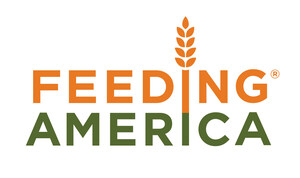CHICAGO, May 15, 2024 /PRNewswire/ -- The extra amount of money that people facing hunger said they need to have enough food reached its highest point in the last 20 years, according to Feeding America's annual Map the Meal Gap study. People facing hunger said they need an additional $24.73 per week in 2022, a 9.5% increase after adjusting for increased prices. Nationally, the amount needed among all 44 million people facing hunger in 2022 hit a record high of $33.1 billion, up nearly 43%. This increase suggests that rising prices, especially food prices, likely contributed in part to the increase in need.
Map the Meal Gap is the only study that provides local-level estimates of food insecurity and food costs for every county and congressional district in the U.S. The study builds upon the USDA's latest report of national and state data, which showed a sharp increase in food insecurity in 2022 amidst historically high food prices and the expiration of many pandemic-era programs. Map the Meal Gap emphasizes the urgent call for all of us to take action.
"The insights from this year's study confirm what we hear from people facing hunger: elevated food prices and the hard choice between other household expenses like electricity, childcare or medical bills is making hunger in America worse," said Linda Nageotte, Feeding America president and chief operating officer. "This powerful tool helps us understand the impact of food insecurity and underlines that we can choose to end hunger in America by coming together as a nation. That's why Feeding America is calling upon Congress to strengthen critical federal nutrition programs that help to feed millions of families, children and individuals."
The national average cost per meal, which reflects how much money people who are food secure report spending on food, also reached its highest point in the last two decades, rising nearly 3% to $3.99 per meal in 2022. High food prices can strain a household's budget when balancing expenses like housing, utilities, transportation and other essentials.
Other key findings of Map the Meal Gap include:
- Food insecurity by geography:
- Food insecurity exists in all 3,144 counties and county equivalents as well as all 435 congressional districts in all 50 states and the District of Columbia.
- Estimated food insecurity levels vary across regions, influenced by factors like unemployment and poverty as well as systems and policies that prevent certain households and communities from accessing the food they need.
- Child food insecurity rates reach almost 50% in some counties.
- Rural counties make up 62% of all U.S counties, but 9 out of 10 counties with high food insecurity are rural.
- 8 out of 10 high food insecurity counties are in the South, indicating regional disparities.
- Income, food spending and costs:
- Nearly 50% of individuals experiencing food insecurity may not qualify for SNAP benefits due to program eligibility restrictions based on household income.
- Meal costs vary significantly by county, ranging from $2.91 to $6.67, showcasing the diverse economic challenges faced by communities.
- Food insecurity by race and ethnicity:
- While nearly 40% of the food insecure population in the U.S. is white, food insecurity rates among Black individuals and Latino individuals exceed those of white individuals in most counties. These disparities are an example of how historical, social, economic and environmental factors have held many communities of color back, creating barriers to food security.
- Racial disparities persist, with significant variations in food insecurity rates across different racial and ethnic groups and geographic locations.
- Data about additional racial and ethnic populations is not available through Map the Meal Gap, but other research shows that additional communities of color, including Native Americans and Native Hawaiian/Pacific Islanders, experience food insecurity at disproportionately high rates.
The Map the Meal Gap study is supported by Conagra Brands Foundation and NielsenIQ/NIQ.
"Conagra Brands Foundation is dedicated to nourishing communities and is proud to partner with Feeding America and its network of more than 200 food banks in our collective efforts to address the ongoing issue of food insecurity. Map the Meal Gap provides essential data and insights regarding the ongoing challenge of food insecurity in our nation, exposing the disproportionate impact that food insecurity has on people and communities of color. We hope this research encourages continued conversation, resulting in actions and solutions that champion equitable access to nutritious food for people in all communities," said Robert J. Rizzo, Senior Director, Community Investment, Conagra Brands and Conagra Brands Foundation.
"NIQ recognizes the ongoing need to address food insecurity within our communities. Our partnership with Feeding America underscores our commitment to support their essential mission of ensuring access to nutritious food for people in need. Together, we are dedicated to building a more equitable and sustainable food system for all through our CPG retailer and manufacturer clients, so that our neighbors can access the food they say they need to thrive," said Kymberly Graham, Vice President and Head of Diversity Initiatives, NIQ, a global measurement and data analytics company.
Additional key takeaways from the report can be found on the Map the Meal Gap website along with an interactive map that details food insecurity by geography, income, race and ethnicity.
Methodology:
Map the Meal Gap uses publicly available data from the USDA ERS, U.S. Census Bureau, and Bureau of Labor Statistics to estimate local food insecurity at the county, congressional district and state levels. The study also estimates local meal costs and food budget shortfalls using food price data from NIQ based on the USDA Thrifty Food Plan, and grocery sales tax data for every county and state in the country.
To learn how food insecurity impacts your community, visit FeedingAmerica.org/MaptheMealGap.
Media Contact
Emily James
Feeding America
About Feeding America
Feeding America is committed to an America where no one is hungry. We support tens of millions of people who experience food insecurity to get the food and resources they say they need to thrive as part of a nationwide network of food banks, statewide food bank associations, food pantries and meal programs. We also invest in innovative solutions to increase equitable access to nutritious food, advocate for legislation that improves food security and work to address factors that impact food security, such as health, cost of living and employment.
We partner with people experiencing food insecurity, policymakers, organizations, and supporters, united with them in a movement to end hunger. Visit www.FeedingAmerica.org to learn more.
About Conagra Brands Foundation
Conagra Brands Foundation believes everyone has a right to healthy and nutritious food knowing that food insecurity exists in every U.S. county. The Foundation partners with exceptional national and local nonprofits with high-impact programs located in the communities where we live and work. By focusing our efforts within five areas: Direct Food Access, Cooking Skills, Nutrition Education, Healthy and Active Lifestyles and Urban Agriculture, we are able to be a leader in the fight against food insecurity in North America. For more information visit https://conagrabrands.com/communitygiving.
About NielsenIQ/NIQ
NIQ is the world's leading consumer intelligence company, delivering the most complete understanding of consumer buying behavior and revealing new pathways to growth. NIQ combined with GfK in 2023, bringing together the two industry leaders with unparalleled global reach. Today NIQ has operations in more than 90 countries covering 90% of the world's population. With a holistic retail read and the most comprehensive consumer insights—delivered with advanced analytics through state-of-the-art platforms—NIQ delivers the Full View™.
SOURCE Feeding America

WANT YOUR COMPANY'S NEWS FEATURED ON PRNEWSWIRE.COM?
Newsrooms &
Influencers
Digital Media
Outlets
Journalists
Opted In





Share this article